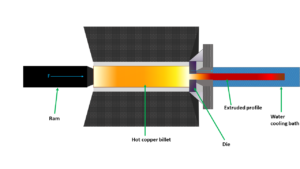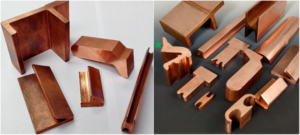Issue 045, Sept 19, 2022
Megan Puglia, Ph.D., Sr. Research Chemist

Figure 1: Schematic of a typical extrusion press depicting the ram pushing the hot copper billet through a shaped die and into a water bath for cooling.
Extrusion is a compressive forming manufacturing process that creates lengths of shaped cross-sections from metal billets. The process utilizes high force to squeeze the material through a shaped die and achieve the final desired shape and size. The die is made with a material with wear resistance and higher hot strength than that being extruded to ensure precise cross-sections and a smooth surface. As one of many compressive forming techniques for metals, extrusion is used for its manufacturing speed, relatively low cost, and resulting smooth finishes.
A multitude of different extrusion processes exist depending on the material to be extruded and its application.¹ In direct extrusion, the most common process, the billet slides against walls of a heated container en route to being extruded through the die. The frictional forces at the container wall exert significant force back on the ram. This “unproductive” frictional work is typically on the same order of magnitude as the “productive” work needed to reduce the cross-section of the billet. During indirect extrusion the die is instead pushed into the container holding the billet, providing a more uniform flow that results in more consistent diameters and microstructures. Indirect extrusion results in less frictional loss and is therefore a faster process that is easier on equipment. A third, more exotic type is hydrostatic extrusion, where an incompressible fluid barrier in the container defeats the elevated wall friction observed in direct extrusion.
Hot extrusions are done above the recrystallization temperature of the metal to be formed helping to prevent work hardening during the process and allowing large changes in shape. Heating the billet also aids in the process of moving the material through the die by reducing the material’s strength, preventing deformation hardening, and lowering the material flow stress.² These combine to allow the material to flow more uniformly through the die, permitting high area reductions and the production of more complex cross-sections. Hot copper extrusions are normally done between 600 and 1000˚C. Using temperatures above the dynamic recrystallization temperature results in a uniform fine grain structure in the final extrusion product. Figure 1 shows a schematic of a hot copper extrusion process. The copper billet is heated, and then pressed through a specifically shaped die with a hydraulic press ram. As the extruded copper bar exits the die it enters a water bath that helps cool the bar and reduce copper oxidation.

Figure 2: Both panels show a small selection of the various, custom copper extrusions that can be made at DNI. The green star marks a DNI extrusion shape that would be considerably more time consuming to make via machining.
Deringer-Ney Inc. (DNI) has extensive experience in the production of specialty-shaped C11000 electrolytic tough pitch (ETP) copper extrusions using a direct, hot extrusion process in Birdsboro, Pennsylvania. This is accomplished by means of a 900-ton Loewy hydraulic extrusion press configured to handle 5 in diameter ETP billets, high speed induction heater, and an in-line water-cooling system that helps to reduce copper oxidation during the extrusion process. Extrusions are brought down to final size on our cold draw bench.
The DNI plant in Englewood, New Jersey offers subassembly capabilities utilizing in-house copper extrusions for a multitude of different parts for various applications including electrical equipment for transit trains, diesel locomotives, low to medium voltage electrical switchgear products, motor control, HVAC, and elevator equipment. Extrusion becomes particularly efficient and useful when complicated cross-sectional shapes are needed on a large scale that cannot be accomplished quickly via machining techniques. Long, extruded lengths with tailored cross-sectional shapes can then be cut into many usable pieces.
Although extrusion can be extremely efficient for certain cross-sectional shapes, there are limits to its efficiency. Copper extrusion for DNI’s press becomes difficult as the cross-sectional area of the part exceeds about three square inches. When the extruded cross-section is larger than this, the extrusion tends to curve slightly as it comes out of the die and is difficult to straighten by cold drawing. Asymmetrical parts also tend to be difficult to make for the same reason. DNI can produce thin sections of an extruded shape with a minimum thickness value of 0.125 inches. Extruded shapes are limited to inside radii of 0.020 inches and above, with virtually no outer radii limits if they accommodate an appropriate die cross-section.
In Figure 2, a multitude of copper extrusion shapes made at DNI are shown. An excellent example of a shape that would be very time-consuming to machine is marked by the green star. Many of these different shapes are used in the electrical industries such as electric motors, industrial switchgear, grounding systems, contactors, and high energy circuit systems. DNI’s combination of experience and extrusion equipment make it an excellent one-stop shop for custom, complex copper extrusion work.
References:
- Kalpakjian, Serope. Mechanical Processing of Materials. Princeton, New Jersey: Van nostrand, 1967.
- “Metal Extrusion.” Metal Extrusion, The Library of Manufacturing, https://thelibraryofmanufacturing.com/extrusion.html.
